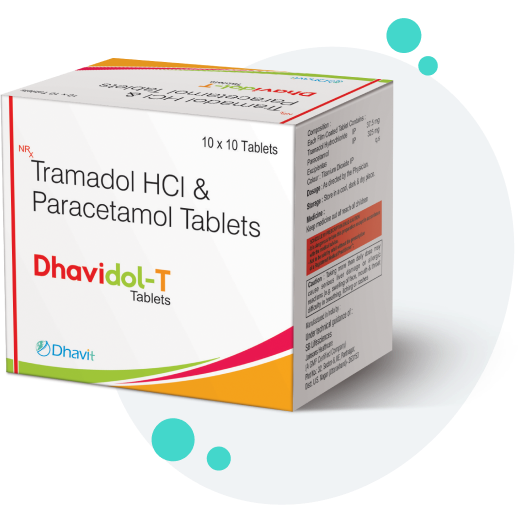
Dhavidol- T Tablets
Composition
| Tramadol: | 37.5 mg |
| Paracetamol: | 325 mg |
Description
Rarely does a single known mechanism cause pain. Obviously, no single analgesic agent can fully address multiple mechanisms of pain.
Combination analgesic products have been effective because they activate multiple pain-inhibitory pathways and offer a broader spectrum of relief. This may include multiple afferents and pathways as well as multiple processes.
Combination analgesics might reduce adverse events. A given analgesic provides pain relief at a specific dosage and is associated with dose-dependent adverse effects. Combining analgesics may allow for lower doses of the individual agents, with doses possibly low enough to significantly reduce potential adverse events. Combining two or more agents may also result in an additive or synergistic analgesic effect.
Tramadol/Paracetamol is a fixed-dose combination where both the dual mechanism of action of tramadol and the analgesic synergy between the two compounds have been demonstrated. 33 Clinical studies have shown good efficacy and safety of this fixed-dose product for a variety of pain conditions
Pharmacology
Paracetamol
Mechanism of action
Paracetamol act primarily in the CNS, increasing the pain threshold by inhibiting both isoforms of cyclooxygenase, COX-1, COX-2, and COX-3 enzymes involved in prostaglandin (PG) synthesis.
The antipyretic properties of Paracetamol are likely due to direct effects on the heat-regulating centres of the hypothalamus resulting in peripheral vasodilation, sweating and hence heat dissipation.
Paracetamol is a widely used analgesic and antipyretic drug that is used for the relief of fever, headaches, and other minor aches and pains.
Paracetamol, unlike other common analgesics such as aspirin and ibuprofen, has no anti-inflammatory properties or effects on platelet function, and it is not a member of the class of drugs known as non-steroidal anti-inflammatory drugs or NSAIDs.
Pharmacokinetics
Paracetamol is readily absorbed from the gastrointestinal tract with peak plasma concentrations occurring about 10 to 60 minutes after oral doses. Paracetamol is distributed into most body tissues. It crosses the placenta and is present in breast milk. Plasma-protein binding is negligible at usual therapeutic concentrations but increases with increasing concentrations.
The elimination half-life of paracetamol varies from about 1 to 3 hours. Paracetamol is metabolised mainly in the liver and excreted in the urine mainly as the glucuronide and sulfate conjugates. Less than 5% is excreted as unchanged paracetamol.
Tramadol
Mechanism of action
Tramadol was the first medication in its class to produce dual-analgesic effects, acting synergistically as an opioid agonist and as a serotonin and norepinephrine reuptake inhibitor. It acts on the μ-opioid receptor as a weak agonist and acts on serotonergic and noradrenergic nociception.
Pharmacokinetics
Tramadol is rapidly distributed in the body; plasma protein binding is about 20%. Tramadol is mainly metabolised by O- and N-demethylation and by conjugation reactions forming glucuronides and sulfates. Tramadol and its metabolites are mainly excreted via the kidneys. The mean elimination half-life is about 6 hours.
Indications
Moderate to severe painful conditions
Undesirable Effects
Common side effects may include
- Dizziness
- drowsiness
- stomach pain
- nausea
- loss of appetite
- diarrhoea / constipation
- sweating
Dosage
The initial dose of Dhavidol-T Tablets is 1-2 tablets every 4 to 6 hours as needed for pain relief up to a maximum of 8 tablets per day.
Packaging Information
Strip of 10 Tablets
Got a question?
We’d love to talk about how we can help you.